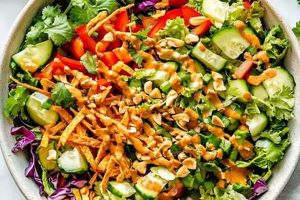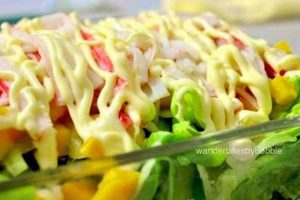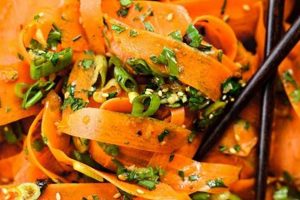Crisp, refreshing, and often subtly spicy, these salads highlight the versatility of cucumbers by combining them with a variety of ingredients commonly found in Asian cuisines. A typical preparation might involve thinly sliced cucumbers tossed with rice vinegar, sesame oil, soy sauce, ginger, garlic, and chili flakes. Variations can include ingredients such as seaweed, peanuts, or other vegetables like carrots and red onion.
Such salads offer a light and flavorful complement to richer dishes, serving as a palate cleanser or a cooling counterpoint to spicier fare. They represent a healthy culinary tradition, offering a vibrant source of hydration and nutrients. Historically, cucumbers have played a significant role in various Asian diets, and these salads reflect the resourcefulness and creativity of adapting simple ingredients into satisfying and flavorful meals. Their adaptability makes them suitable for everyday meals, festive occasions, or as a part of a larger banquet spread.
The following sections will delve deeper into the diverse world of these culinary creations, exploring specific regional variations, ingredient substitutions, and techniques for achieving the perfect balance of flavors and textures.
Tips for Crafting Exceptional Cucumber Salads
Achieving optimal flavor and texture requires attention to detail throughout the preparation process. These tips offer guidance for creating truly remarkable cucumber salads.
Tip 1: Salt and Drain Cucumbers: Salting sliced cucumbers draws out excess moisture, preventing a watery salad. After salting, allow the cucumbers to rest for 15-20 minutes, then gently press or pat them dry.
Tip 2: Select the Right Cucumber: English or Persian cucumbers, with their thinner skins and fewer seeds, are ideal choices. Standard cucumbers can be used, but peeling and seeding them is recommended.
Tip 3: Balance Flavors: Harmonize the saltiness of soy sauce with the sweetness of sugar or mirin, the acidity of vinegar, and the heat of chili. Taste and adjust seasonings as needed.
Tip 4: Toast Sesame Seeds: Toasting sesame seeds enhances their nutty aroma and adds a delicate crunch. Toast briefly in a dry pan over medium heat until fragrant and lightly golden.
Tip 5: Use Quality Ingredients: Opt for fresh, high-quality ingredients, especially when it comes to aromatics like ginger and garlic. The difference in flavor is noticeable.
Tip 6: Chill Before Serving: Allowing the salad to chill in the refrigerator for at least 30 minutes enhances the flavors and provides a refreshing element.
Tip 7: Consider Garnishes: Fresh herbs like cilantro or mint, toasted peanuts, or a sprinkle of black sesame seeds can elevate the visual appeal and add another layer of flavor.
By following these guidelines, one can create a cucumber salad that is not only visually appealing but also offers a balanced and delightful culinary experience.
The following section will provide a selection of diverse recipes, allowing exploration of various flavor profiles and regional adaptations.
1. Cucumber Preparation
Proper cucumber preparation is fundamental to a successful Asian cucumber salad. It directly influences the final dish’s texture, flavor absorption, and overall aesthetic appeal. The techniques employed determine how the cucumber integrates with other ingredients and contributes to the sensory experience.
- Slicing Technique
The way cucumbers are sliced impacts both texture and visual presentation. Thin slices create a delicate, almost translucent appearance and readily absorb the dressing’s flavors. Thicker slices offer more crunch. Julienned or shredded cucumbers offer a different textural dimension. Matching the slicing style to the desired outcome is key.
- Salting and Draining
Salting draws out excess moisture from cucumbers, preventing a watery salad and concentrating their flavor. This step is particularly important for cucumbers with high water content. After salting, the cucumbers should rest for a period, then be gently pressed or patted dry to remove the released liquid. This process ensures a crisp, flavorful salad.
- Peeling and Seeding
While optional, peeling and seeding cucumbers can refine the salad’s texture and appearance. Peeling removes the sometimes bitter skin, while seeding eliminates the watery core. This is often recommended for larger, more mature cucumbers. English or Persian cucumbers, with their thinner skins and fewer seeds, generally do not require this step.
- Chilling
Chilling the prepared cucumbers before incorporating them into the salad enhances their refreshing qualities. This step also helps maintain the salad’s crispness and prevents wilting, especially in warmer climates. Briefly chilling the cucumbers before serving intensifies the cooling sensation.
These preparatory steps are essential for optimizing the cucumber’s contribution to the overall flavor and textural profile of the Asian cucumber salad. Careful attention to these details elevates the dish from simple to exceptional.
2. Flavor Balancing
Flavor balancing is paramount in achieving a harmonious and palatable Asian cucumber salad. The interplay of tastesprimarily sweet, sour, salty, and spicydefines the character of the dish. A well-balanced salad avoids extremes, allowing each element to complement the others without dominance. This balance is achieved through careful consideration of ingredient proportions and their individual flavor profiles.
The foundational element of saltiness often comes from soy sauce, fish sauce, or salt itself. Sourness is introduced through rice vinegar, black vinegar, or citrus juices. Sweetness can be derived from sugar, mirin, or honey, acting as a counterpoint to the salty and sour components. Finally, the level of spiciness, typically contributed by chili flakes, fresh chilies, or chili oil, is adjusted to preference, adding a layer of complexity and stimulating the palate. For example, a Vietnamese-style cucumber salad might emphasize fish sauce and lime juice for a salty and sour profile, while a Korean version could lean towards a spicier and sweeter balance using gochujang (Korean chili paste) and a touch of sugar.
Understanding these flavor dynamics allows for informed adjustments and substitutions. If a salad tastes overly salty, a touch of sweetness or acidity can restore balance. Similarly, an excess of sourness can be tempered with a pinch of sugar or a milder vinegar. Mastery of flavor balancing ensures a consistently delicious and nuanced cucumber salad, adaptable to individual preferences and regional variations. This principle, applied thoughtfully, elevates the simple cucumber to a complex and satisfying culinary experience.
3. Ingredient Selection
Ingredient selection significantly impacts the flavor profile and authenticity of an Asian cucumber salad. The choice of components extends beyond the cucumber itself, encompassing a range of aromatics, spices, and sauces that contribute to the dish’s complexity. A careful selection process considers not only individual flavors but also their interaction within the salad’s overall composition.
Aromatic ingredients like ginger, garlic, and shallots form the foundational flavor base of many Asian cucumber salads. Ginger provides a subtle heat and a refreshing zest, while garlic adds pungency and depth. Shallots contribute a milder onion flavor, enhancing the overall aroma. These aromatics, often minced or finely chopped, infuse the salad with their distinct characteristics.
Spices and seasonings further define the salad’s character. Chili flakes introduce heat, while toasted sesame seeds offer a nutty aroma and a delicate crunch. Fresh herbs, such as cilantro, mint, or Thai basil, contribute bright, herbaceous notes, enhancing the salad’s freshness. The considered use of spices elevates the salad beyond its basic components, creating a multi-layered sensory experience.
Sauces and liquids are essential for binding the ingredients and imparting distinct flavor profiles. Rice vinegar provides a mild acidity, while soy sauce contributes saltiness and umami. Sesame oil adds a rich, nutty flavor, and fish sauce, commonly used in Southeast Asian cuisines, introduces a savory depth. The choice of sauce significantly influences the overall taste and cultural authenticity of the salad.
For instance, a Japanese-inspired cucumber salad might incorporate rice vinegar, soy sauce, and sesame oil, while a Thai version could feature fish sauce, lime juice, and chili. These choices reflect regional culinary traditions and influence the final product’s character. Understanding these ingredient relationships and their regional variations allows for informed choices, contributing to a more authentic and flavorful outcome.
Successful ingredient selection hinges on understanding the desired flavor profile and the interplay of individual components. Careful consideration of these elements ensures a balanced and delicious Asian cucumber salad that reflects the richness and diversity of Asian culinary traditions.
4. Regional Variations
Regional variations in Asian cucumber salads reflect the diverse culinary traditions and ingredient availability across the continent. These variations highlight the adaptability of the basic concept, showcasing how a simple dish can transform into distinct culinary experiences through the incorporation of unique ingredients and flavor profiles. Examining these regional adaptations provides valuable insights into the broader context of Asian cuisine and the creative use of local resources.
- Southeast Asian Influence (e.g., Vietnam, Thailand)
Southeast Asian variations often emphasize fresh herbs, such as mint, cilantro, and Thai basil, alongside the prominent use of fish sauce, lime juice, and chilies. The resulting salads are vibrant, aromatic, and often pack a punch of heat. The emphasis on fresh, locally sourced ingredients reflects the region’s tropical climate and culinary philosophy. A Vietnamese goi dua chuot, for example, features thinly sliced cucumbers with shrimp, peanuts, and a tangy dressing, while a Thai cucumber salad might incorporate lemongrass and kaffir lime leaves for a distinctly aromatic profile.
- East Asian Simplicity (e.g., Japan, Korea)
East Asian cucumber salads frequently showcase a minimalist approach, focusing on clean flavors and simple preparations. Rice vinegar, sesame oil, and soy sauce are common seasonings, creating a balanced and refreshing taste. Japanese sunomono, for example, highlights the natural flavors of the cucumber, often enhanced with a sprinkle of seaweed or sesame seeds. Korean oi muchim often incorporates gochugaru (Korean chili flakes) and garlic for a spicy and pungent kick.
- South Asian Spices (e.g., India, Pakistan)
South Asian cucumber salads often feature a more complex blend of spices, reflecting the region’s rich culinary heritage. Ingredients like cumin, coriander, and turmeric might be incorporated, alongside yogurt or raita for a cooling element. These salads often accompany larger meals, providing a refreshing counterpoint to richer dishes. A kachumber salad, common in Indian cuisine, combines diced cucumbers, tomatoes, and onions with a simple lemon and chaat masala dressing.
- Chinese Regional Diversity
The vastness of China encompasses a wide range of regional cucumber salad variations. Sichuan cuisine might incorporate spicy chili oil and Sichuan peppercorns, while Cantonese versions might emphasize a lighter, sweeter flavor profile. The use of preserved or pickled ingredients, like mustard greens or ginger, can also add complexity and depth to the salad. A smashed cucumber salad, popular throughout China, features cucumbers lightly crushed to absorb the dressing more readily.
These diverse regional variations exemplify the adaptability of the cucumber salad within Asian cuisine. By exploring these distinct approaches, one gains a deeper appreciation for the interplay of ingredients, flavors, and cultural influences that shape culinary traditions across the continent. Each regional variation offers a unique perspective on this seemingly simple dish, demonstrating the ingenuity and creativity of Asian culinary practices.
5. Serving Suggestions
Serving suggestions for Asian cucumber salads are integral to maximizing their culinary impact. Consideration of the salad’s flavor profile, accompanying dishes, and the overall dining experience influences how these salads are best presented and enjoyed. Strategic serving enhances the salad’s contribution to the meal, whether as a refreshing appetizer, a palate-cleansing side dish, or an element within a larger, more complex culinary narrative.
As a light and refreshing starter, an Asian cucumber salad can stimulate the appetite and prepare the palate for subsequent courses. Its crispness and bright flavors provide a welcome contrast to richer dishes, acting as a palate cleanser between courses or as a cooling counterpoint to spicy main dishes. For example, a spicy Sichuan dish benefits from the cooling properties of a cucumber salad with rice vinegar and sesame oil. Similarly, the richness of a Korean barbecue finds balance with a kimchi-style cucumber salad. Incorporating the salad within a larger meal allows it to play a specific role, enhancing the overall dining experience. A Vietnamese summer roll, for example, incorporates fresh cucumber and herbs for both texture and flavor.
The presentation of the salad also plays a crucial role. A simple arrangement in a small bowl emphasizes its refreshing simplicity, while a more elaborate presentation on a platter, garnished with fresh herbs or toasted nuts, adds a touch of elegance to a larger spread. Understanding the context of the meal allows for informed decisions regarding portion size and presentation, ensuring the cucumber salad complements the overall dining experience. The practical application of these serving suggestions allows the Asian cucumber salad to transcend its seemingly simple nature, transforming into a versatile culinary element capable of enhancing a wide range of dining occasions.
6. Dietary Adaptations
Dietary adaptations play a crucial role in ensuring Asian cucumber salads are accessible to a wider range of individuals with specific dietary needs or preferences. These adaptations involve thoughtful substitutions and ingredient considerations without compromising the fundamental flavors and textures characteristic of these salads. The ability to modify recipes allows individuals with dietary restrictions to enjoy the culinary and cultural significance of these dishes.
Common dietary adaptations include addressing gluten sensitivities, managing sodium intake, accommodating vegan or vegetarian diets, and navigating allergies to specific ingredients such as nuts or shellfish. For gluten-free adaptations, tamari or coconut aminos can replace traditional soy sauce. Reducing sodium can be achieved by using low-sodium soy sauce or simply decreasing the amount used in the dressing. Vegan and vegetarian diets can be accommodated by omitting fish sauce and ensuring any added protein sources, such as dried shrimp, are plant-based. Nut allergies require careful attention to garnishes and the exclusion of ingredients like sesame oil or peanuts. Substituting sunflower or grapeseed oil for sesame oil and replacing peanuts with toasted pumpkin or sunflower seeds maintains flavor and texture while accommodating dietary restrictions.
Understanding these dietary adaptations empowers individuals to modify Asian cucumber salad recipes without sacrificing authenticity or flavor. It promotes inclusivity and allows a wider audience to appreciate the diverse culinary traditions represented by these salads. Careful consideration of dietary needs enhances the accessibility and enjoyment of these dishes, demonstrating the adaptability and versatility of Asian cuisine.
Frequently Asked Questions
This section addresses common inquiries regarding Asian cucumber salads, providing clear and concise information to enhance understanding and facilitate successful preparation.
Question 1: What type of cucumber is best suited for these salads?
English or Persian cucumbers are generally preferred due to their thinner skins, smaller seeds, and less watery nature. However, standard cucumbers can be used; peeling and seeding them is recommended.
Question 2: How can a watery salad be avoided?
Salting the sliced cucumbers and allowing them to drain for 15-20 minutes before incorporating them into the salad draws out excess moisture. Gently pressing or patting the cucumbers dry further reduces water content.
Question 3: What are common substitutions for soy sauce for gluten-free diets?
Tamari or coconut aminos offer suitable gluten-free alternatives to traditional soy sauce, maintaining a similar salty and umami flavor profile.
Question 4: How can the spiciness level be adjusted?
The amount of chili flakes, fresh chilies, or chili oil can be adjusted to suit individual preferences. Start with a small amount and gradually increase until the desired level of heat is reached.
Question 5: How long can the salad be stored in the refrigerator?
Asian cucumber salads are best consumed fresh. However, they can be stored in an airtight container in the refrigerator for up to 2 days. The texture may soften slightly over time.
Question 6: Can these salads be served warm?
While typically served chilled, some variations can be served at room temperature or slightly warmed. Serving temperature can influence the flavor profile and textural experience.
Understanding these frequently asked questions clarifies key aspects of preparation and enjoyment. Experimentation with ingredients and techniques allows for personalized variations within the established culinary framework.
The following section offers a selection of diverse recipes, allowing for practical application of these principles.
Asian Cucumber Salad Recipe
Exploration of Asian cucumber salad recipes reveals a diverse culinary landscape. From the fundamental elements of cucumber preparation and flavor balancing to the nuanced selection of ingredients and regional variations, these salads demonstrate a remarkable adaptability. Careful consideration of dietary adaptations further expands accessibility, ensuring a wider audience can appreciate the refreshing simplicity and complex flavor profiles these dishes offer. Key insights regarding slicing techniques, moisture control, and the interplay of sweet, sour, salty, and spicy elements provide a foundation for successful preparation. The examination of regional influences, from Southeast Asian herbs and spices to East Asian minimalist approaches and South Asian spice blends, underscores the rich culinary heritage reflected in these seemingly simple salads.
Asian cucumber salad recipes offer a versatile culinary canvas, inviting exploration and adaptation. Continued experimentation with ingredients, techniques, and cultural influences promises further innovation and a deeper appreciation for the artistry of balancing flavors and textures. The refreshing simplicity of these salads belies a complex interplay of culinary principles, inviting both novice and experienced cooks to explore the diverse world of Asian cuisine.






